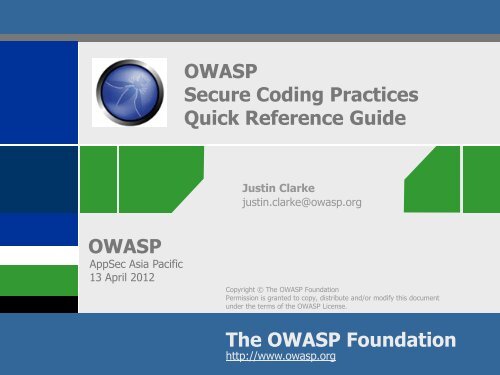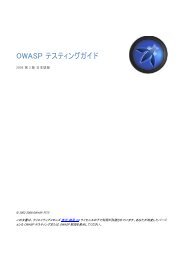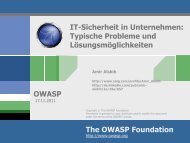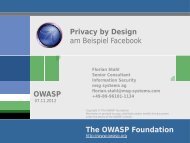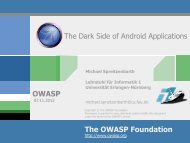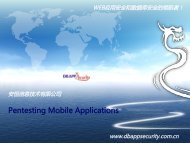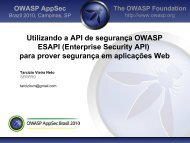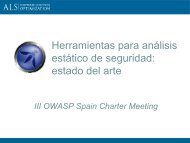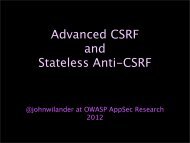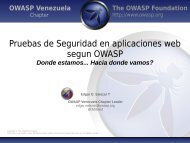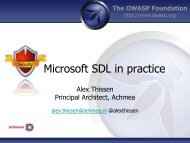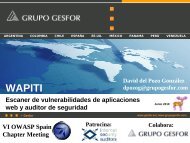OWASP Project:Secure Coding Quick Reference Guide
OWASP Project:Secure Coding Quick Reference Guide
OWASP Project:Secure Coding Quick Reference Guide
You also want an ePaper? Increase the reach of your titles
YUMPU automatically turns print PDFs into web optimized ePapers that Google loves.
<strong>OWASP</strong><br />
<strong>Secure</strong> <strong>Coding</strong> Practices<br />
<strong>Quick</strong> <strong>Reference</strong> <strong>Guide</strong><br />
Justin Clarke<br />
justin.clarke@owasp.org<br />
<strong>OWASP</strong><br />
AppSec Asia Pacific<br />
13 April 2012<br />
Copyright © The <strong>OWASP</strong> Foundation<br />
Permission is granted to copy, distribute and/or modify this document<br />
under the terms of the <strong>OWASP</strong> License.<br />
The <strong>OWASP</strong> Foundation<br />
http://www.owasp.org
Some Background<br />
Goal: Build a secure coding kick-start tool, to help<br />
development teams quickly understand secure coding<br />
Originally developed for use inside The Boeing Company<br />
July 2010, Boeing assigned copyright to <strong>OWASP</strong><br />
August 2010, project goes live on owasp.org<br />
November 2010, SCP v2 goes live (current stable version)<br />
<strong>OWASP</strong><br />
2
<strong>Project</strong> Structure / Localizations<br />
• English – Keith Turpin (<strong>Project</strong> leader)<br />
• Korean<br />
• Portuguese<br />
• Brazilian Portuguese<br />
• Spanish<br />
• https://www.owasp.org/index.php/<strong>OWASP</strong>_<strong>Secure</strong>_Codi<br />
ng_Practices_-_<strong>Quick</strong>_<strong>Reference</strong>_<strong>Guide</strong><br />
<strong>OWASP</strong><br />
3
<strong>Guide</strong> Overview<br />
Technology agnostic coding practices<br />
What to do, not how to do it<br />
Compact, but comprehensive checklist format<br />
Focuses on secure coding requirements, rather<br />
then on vulnerabilities and exploits<br />
Includes a cross referenced glossary to get<br />
developers and security folks talking the same<br />
language<br />
<strong>OWASP</strong><br />
4
Sections of the <strong>Guide</strong><br />
The bulk of the document is in the checklists, but it<br />
contains all of the following:<br />
Table of contents<br />
Introduction<br />
Software Security Principles Overview<br />
<strong>Secure</strong> <strong>Coding</strong> Practices Checklist<br />
Links to useful resources<br />
Glossary of important terminology<br />
<strong>OWASP</strong><br />
5
Checklist Sections<br />
- Only 9 pages long<br />
‣ Input Validation<br />
‣ Output Encoding<br />
‣ Authentication and Password<br />
Management<br />
‣ Session Management<br />
‣ Access Control<br />
‣ Cryptographic Practices<br />
‣ Data Protection<br />
‣ Communication Security<br />
‣ System Configuration<br />
‣ Database Security<br />
‣ File Management<br />
‣ Memory Management<br />
‣ General <strong>Coding</strong> Practices<br />
‣ Error Handling and Logging<br />
<strong>OWASP</strong><br />
6
Checklist Practices<br />
Short and to the point<br />
Straight forward "do this" or "don't do that"<br />
Does not attempt to rank the practices<br />
Some practices are conditional recommendations that<br />
depend on the criticality of the system or information<br />
The security implications of not following any of the<br />
practices that apply to the application, should be clearly<br />
understood<br />
<strong>OWASP</strong><br />
7
Extract - Database Security<br />
Use strongly typed parameterized queries<br />
Utilize input validation and output encoding and be sure to address meta characters.<br />
If these fail, do not run the database command<br />
Ensure that variables are strongly typed<br />
The application should use the lowest possible level of privilege when accessing the<br />
database<br />
Use secure credentials for database access<br />
Do not provide connection strings or credentials directly to the client. If this is<br />
unavoidable, encrypted them<br />
Use stored procedures to abstract data access<br />
Close the connection as soon as possible<br />
Remove or change all default database administrative passwords. Utilize strong<br />
passwords/phrases or implement multi-factor authentication<br />
Turn off all unnecessary database functionality (e.g., unnecessary stored procedures<br />
or services, utility packages, install only the minimum set of features and options<br />
required (surface area reduction))<br />
<strong>OWASP</strong><br />
8
Using the guide<br />
Scenario #1: Developing Guidance Documents<br />
<strong>Coding</strong> Practices<br />
Guiding Principles What to do How to do it<br />
General<br />
Security<br />
Policies<br />
Application<br />
Security<br />
Procedures<br />
Application<br />
Security<br />
<strong>Coding</strong><br />
Standards<br />
<strong>OWASP</strong><br />
9
Using the guide continued<br />
Scenario #2: Support <strong>Secure</strong> Development Lifecycle<br />
What to do How you should do it What you did Did it work<br />
Application<br />
Security<br />
Requirements<br />
<strong>Secure</strong> Development<br />
Processes<br />
Standardized Libraries<br />
Review<br />
Solutions<br />
Test Solution<br />
Implementation<br />
Standard Guidance for<br />
non-Library Solutions<br />
<strong>Coding</strong> Practices<br />
<strong>OWASP</strong><br />
10
Using the guide continued<br />
Scenario #3: Contracted Development<br />
• Identify security requirements to be added to outsourced<br />
software development projects.<br />
• Include them in the RFP and Contract<br />
How do I<br />
make it work<br />
We can build<br />
anything<br />
<strong>Coding</strong> Practices<br />
I need<br />
cool<br />
Software<br />
RFP<br />
Best<br />
Software<br />
Best<br />
Ever<br />
Software<br />
Ever<br />
Contract<br />
Programmer<br />
Salesman<br />
Customer<br />
<strong>OWASP</strong><br />
11
Summary<br />
Makes it easier for development teams to quickly<br />
understand secure coding practices<br />
Assists with defining requirements and adding them to<br />
policies and contracts<br />
Provides a context and vocabulary for interactions with<br />
security staff<br />
Serves as an easy desk reference<br />
<strong>OWASP</strong><br />
12
A <strong>Secure</strong> Development Framework<br />
Guidance on implementing a secure software development framework is<br />
beyond the scope of the <strong>Quick</strong> reference <strong>Guide</strong>, however the following<br />
<strong>OWASP</strong> projects can help:<br />
Implement a secure software development lifecycle<br />
<strong>OWASP</strong> CLASP <strong>Project</strong><br />
OpenSAMM<br />
Establish secure coding standards<br />
<strong>OWASP</strong> Development <strong>Guide</strong> <strong>Project</strong><br />
Build a re-usable object library<br />
<strong>OWASP</strong> Enterprise Security API (ESAPI) <strong>Project</strong><br />
Verify the effectiveness of security controls<br />
<strong>OWASP</strong> Application Security Verification Standard (ASVS)<br />
<strong>Project</strong>)<br />
Establish secure outsourced development practices including<br />
defining security requirements and verification methodologies in<br />
both the RFP and contract<br />
<strong>OWASP</strong> Legal <strong>Project</strong><br />
<strong>OWASP</strong><br />
13
Questions<br />
<strong>OWASP</strong><br />
14


